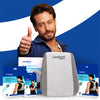If you’ve ever felt a sharp, nagging pain on the outside of your elbow after a long day of typing, gardening, playing or even lifting groceries. Then, this is the time to handle it with patience and guidance. This common condition, known as tennis elbow (or lateral epicondylitis), affects athletes on the major side. It’s not just limited to tennis players but anyone who uses their hands repetitively while engaging in activities such as typing, gripping, gardening, lifting weights, and daily activities can easily develop it.
It’s an overuse injury that can turn your everyday tasks into painful challenges. But the best thing about it is that relief and prevention can be surprisingly simple. Now you must be wondering how? Simply switching to a small, lightweight support, a tennis elbow support band, can noticeably make your healing journey more effective and easier.
This blog will answer all your pressing questions about using an elbow support band, turning confusion into clarity and pain into comfort.
Does Wearing a Band Help with Tennis Elbow?
Absolutely, and here’s the simple science behind it. Tennis elbow is caused by strain in the tendons of your forearm muscles. These tendons attach to a bony bump on the outside of your elbow. When you overuse these muscles, the tendon fibers become irritated and inflamed.
A tennis elbow brace works like a smart anchor. By applying targeted pressure to the muscles of your forearm, just below the painful spot. It absorbs strain and vibration before it can travel up to the tendon. This doesn't just mask the pain; it actively allows the inflamed tendon to rest and heal, even while you’re moving.
How to Use a Tennis Elbow Support Band Correctly
Simply strapping on a band isn’t enough. Placement is everything for it to be effective. An incorrectly placed tennis elbow support might do very little, leaving you frustrated. Follow these simple steps for maximum relief.
Step 1: Identify the Spot of Maximum Tenderness
Feel for the bony prominence on the outside of your elbow. This is your lateral epicondyle. Now, move your fingers about one to two inches (or two finger widths) down your forearm towards your wrist. This general area is your target zone.
Step 2: Position the Pad
If your elbow support band has a silicone or gel pad (like the one in the Leeford support, which is designed for targeted compression and comfort), this should be placed directly over the most tender spot you just identified in that target zone. The pad is the key player; it’s what provides the focused pressure to relieve radiating pain.
Step 3: Secure the Strap
Wrap the band snugly around your forearm. It should fit snugly and comfortably without being too tight and too loose. Make sure to an extent that you may be able to slide a finger underneath the strap easily. Doing, so enhances your circulation without hampering it, and with the right level of support.
Step 4: Perform the Test
Check for the right placement, for that make a fist with your hand and gently bend your wrist backwards against slight resistance. You can use your other hand to provide it, so that you can feel the forearm muscles tighten. If the tennis elbow brace is placed correctly, the pressure from the pad will reduce the strain and pain you feel at the elbow during this movement.
How Long Should You Wear a Tennis Elbow Band?
This question plays a crucial role, as it helps with your elbow healing. The more explained answer is a balance between support and dependency.
During Activities: The primary time to wear your tennis elbow support band is when you are engaged in activities that may hurt your elbow. These activities include typing on a computer, lifting weights, playing sports, holding tools, and even doing household chores like cooking and cleaning. It’s your protective shield during the storm.
How Many Hours a Day: You can safely wear it for most of your waking hours, especially if you have a physically demanding job or hobby like playing tennis, squash, and badminton etc. However, always give your elbow, muscles or skin a break necessary to maintain a healthy lifestyle and balance.
When to Take it Off: Remove the band during periods of rest, when you’re sleeping, or when your arm is not in use. Always follow your doctor's advice for your best needs and recovery. Limited or targeted compression and warmth are beneficial for healing but constant and uninterrupted compression isn't necessary for healing and can end up irritating your skin. Thus, listen to your body's needs.
If you feel any numbness or tingling sensation in your hand, wrist or fingers, loosen or remove the band immediately. Think of your tennis elbow support as an active partner in your recovery. Meanwhile, it's not a permanent fixture for your tennis elbow, golfer's elbow but a strategic orthopedic Leeford Ortho Tennis Elbow Support. It significantly helps you get through your day pain-free while your tendon heals and recovers.
Wrapping Up
Dealing with persistent elbow pain can be disheartening, but an elbow support band is a proven, user-friendly first step toward reclaiming your comfort and mobility. Therefore, it is of huge importance to understand how it works, where to place it, and when to wear it, etc. This helps you empower yourself to take control of your recovery.
Consistency is key. So, always combine the use of your support band with rest, gentle stretching, and strengthening exercises as recommended by a healthcare professional. Because with the right approach, you make sure that dull ache doesn’t have to be a permanent part of your daily life and routines.
So, the next time you feel that familiar twinge of pain while lifting or typing, strap on your Leeford Ortho tennis elbow support band, simply adjust it right below your elbow, and let it do its job. Sometimes, relief doesn’t come from stopping but it comes from supporting.





